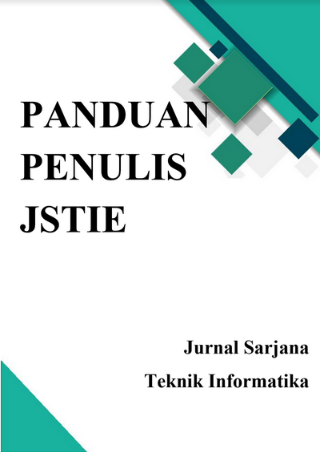Rekonstruksi 3D Untuk Model Wajah Virtual Akademik Menggunakan Sensor Kinect 2
DOI:
https://doi.org/10.12928/jstie.v1i1.19014Keywords:
Kinect 2, Modeling 3D, MMOG, Game VirtualAbstract
Massive multiplayer online game (MMOG) seperti world of warcraft, aion atau second life telah mendapatkan perhatian luar biasa pada perkembangan game vitual. Salah satu kelebihan MMOG pada game virtual setiap player dapat berkomunikasi secara langsung yang di wakili dengan karakter visual tiga dimensi. MMOG juga mendukung grafik permainan pada komputer hingga permainan yang digunakan menggunakan karakter visual tiga dimensi menjadi terlihat nyata.
Penelitian ini memanfaatkan alat sensor kinect 2 dan Microsoft Kinect yang membantu untuk merekam avatar tiga dimensi yang dapat dipersonalisasikan. Dari perkembangan alat sensor yang bernama Kinect 2 sensor dapat mempermudah rekontruksi 3D untuk model wajah pada avatar game virtual dan di proses menggunakan teknik modeling 3D hingga visual dari hasil sensor Kinect 2 menggambarkan tampak nyata dari player dalam bentuk visual.
Penelitian ini menghasilkan rekontruksi 3D untuk model wajah pada avatar game virtual akademik menggunakan sensor Kinect 2. Hasil pengujian SUS untuk uji modelling dan visual avatar 3D menghasilkan nilai rata-rata 41,6 dari sekala 5, maka masuk kategori acceptable yang artinya aplikasi dapat diterima.
References
Basir, Badirun and Zahir Zainuddin. 2017. “Sistem Keamanan Rumah Berbasis Kinect.†8(2):84–96.
Hartono, Hartono, Liliana Liliana, and Rolly Intan. 2015. “Pendeteksian Gerak Menggunakan Sensor Kinect for Windows.†Jurnal Infra 3(2):pp-375.
Henry, Peter, Michael Krainin, Evan Herbst, Xiaofeng Ren, and Dieter Fox. 2012. “RGB- D Mapping: Using Kinect-Style Depth Cameras for Dense 3D Modeling of Indoor Environments.†International Journal of Robotics Research 31(5):647–63.
Izadi, Shahram, David Kim, Otmar Hilliges, David Molyneaux, Richard Newcombe, Pushmeet Kohli, Jamie Shotton, Steve Hodges, Dustin Freeman, Andrew Davison, and Andrew Fitzgibbon. 2011. “78 - KinectFusion Realtime.Pdf.†(11).
Luo, Linbo, Suiping Zhou, Wentong Cai, Malcolm Yoke, Hean Low, Feng Tian, Yongwei Wang, Xian Xiao, and Dan Chen. 2008. “Agent-Based Human Behavior Modeling.†Computer Animation And Virtual Worlds (August):271–81.
Zhang, Jingc , Qian Huang, and Xiang Peng. 2016. “3D Reconstruction of Indoor Environment Using the Kinect Sensor.†Proceedings - 5th International Conference on Instrumentation and Measurement, Computer, Communication, and Control, IMCCC 2015 538–41.
Zhang, Zhengyou. 2012. “Microsoft Kinect Sensor and Its Effect.†IEEE Multimedia
(2):4–10.
Mathe, Z., 2011, Inside Kinect: Skeletal Tracking Deep Dive, Microsoft Kinect Developer Summit, URL: http://www.microsoft.com/download/en/confirmati on. aspx?id=26098, Akses tanggal 25 Mei 2019.
Ratha, S., Ardiyanto, I., Hartanto, R., 2018, 3D Human Face Reconstruction Using Depth Sensor of Kinect 2, Tesis S-2 Universitas Gajah Mada Yogyakarta.
Tanojo, Ricky, et al., 2013, Aplikasi Rekonstruksi 3D Menggunakan Metode Voting- Based Voxel Carving, Jurnal Infra 1(2).
Downloads
Published
Issue
Section
License
License and Copyright Agreement
In submitting the manuscript to the journal, the authors certify that:
- They are authorized by their co-authors to enter into these arrangements.
- The work described has not been formally published before, except in the form of an abstract or as part of a published lecture, review, thesis, or overlay journal. Please also carefully read Journal Posting Your Article Policy.
- The work is not under consideration for publication elsewhere.
- The work has been approved by all the author(s) and by the responsible authorities – tacitly or explicitly – of the institutes where the work has been carried out.
- They secure the right to reproduce any material that has already been published or copyrighted elsewhere.
- They agree to the following license and copyright agreement.
Copyright
Authors who publish with Jurnal Sarjana Teknik Informatika agree to the following terms:
- Authors retain copyright and grant the journal right of first publication with the work simultaneously licensed under a Creative Commons Attribution License (CC BY-SA 4.0) that allows others to share the work with an acknowledgement of the work's authorship and initial publication in this journal.
- Authors are able to enter into separate, additional contractual arrangements for the non-exclusive distribution of the journal's published version of the work (e.g., post it to an institutional repository or publish it in a book), with an acknowledgement of its initial publication in this journal.
- Authors are permitted and encouraged to post their work online (e.g., in institutional repositories or on their website) prior to and during the submission process, as it can lead to productive exchanges, as well as earlier and greater citation of published work.








